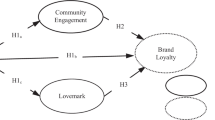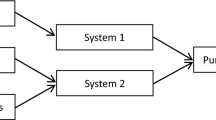Abstract
Native species are elements of a place that have the potential to represent a tourism destination. The possibility of using native species for destination branding has not been systematically investigated. This research was a preliminary attempt to ascertain the efficacy of using native species in destination branding efforts and hypothesizes that if the perceived personality of a species and the perceived personality of the place of its natural range are similar, there would be a good case for adopting the species as a destination branding tool. Using Salmon as the native species and the state of Alaska as the place, the results of the study indicate that Alaska and Salmon have analogous personalities and that the closer a consumer perceived the personalities to be the more likely they were to think that Salmon represented Alaska well. Initial results verify the potential of native species to uniquely represent place with yet unrealized potential.

Similar content being viewed by others
References
Aaker, D.A. (2004) Brand Portfolio Strategy: Creating Relevance, Differentiation, Energy, Leverage, and Clarity. New York: Free Press.
Aaker, D.A. (2005) Strategic Market Management, 7th edn. Hoboken, NJ: John Wiley & Sons.
Aaker, J.L. (1997) Dimensions of brand personality. Journal of Marketing Research 34 (3): 347–356.
Agriculture and Agri-Food Canada. (2008). http://www.ats-sea.agr.gc.ca/supply/3310_e.htm, accessed 8 February 2009.
American Marketing Association (AMA). (n.d.). http://www.marketingpower.com/mg-dictionary-view329.php, accessed 28 April 2008.
Anholt, S. (2007) Competitive Identity: The New Brand Management for Nations, Cities and Regions. Basingstoke, UK: Palgrave Macmillan.
Benedict, R. (1934) Patterns of Culture. Boston, NY: Houghton Mifflin.
Bessiere, J. (1998) Local development and heritage: Traditional food and cuisine as tourist attractions in rural areas. Sociologia Ruralis 38 (1): 21–34.
Boas, F. (1894) Chinook Texts. Washington DC: Government Printing Office.
Cai, L. (2002) Cooperative branding for rural destinations. Annals of Tourism Research 29 (3): 720–742.
Campbell, J. (1988) The Power of Myth. New York: Doubleday.
Chamberlain, A.F. (1891) The maple amongst the Algonkian tribes. American Anthropologist 4 (1): 39–44.
Chinook Salmon Legend. (2007) Lewis and Clark and the Indian Country: 200 years of American history, http://www.newberry.org/lewisandclark/brilliantplan/creators/salmon.asp, accessed 28 February 2007.
Dudley, K. (1996) Giant Pandas. Calgary, Canada: Weigl Educational Publishers.
Ekinci, Y. and Hosany, S. (2006) Destination personality: An application of brand personality to tourism destinations. Journal of Travel Research 45 (2): 127–139.
Forristal, L.J. and Lehto, X.Y. (2008) Native Species Contribution to Sense of Place: The Case of the Provençal Cicada, Proceedings of the 13th Annual Graduate Education and Graduate Student Research Conference in Hospitality and Tourism; 3–5 January, Rosen College of Hospitality Management at the University of Central Florida, Orlando, Florida.
Gifts from the Creator. (2007) Lewis and Clark and the Indian Country: 200 Years of American History, http://www.newberry.org/lewisandclark/today/salmon/gifts.asp, accessed 28 February 2007.
Gunn, C.A. and Var, T. (2002) Tourism Planning: Basics, Concepts, Cases, 4th edn. New York: Routledge.
Gunther, E. (1926) An analysis of the first salmon ceremony. American Anthropologist 28 (4): 605–617.
Hamlin, R.P. and Leith, K.J. (2006) Studying the country-of-origin cue in action: An experimental examination of wine evaluations in the United Kingdom and New Zealand. Place Branding and Public Diplomacy 2 (4): 311–320.
Haven-Tang, C. and Jones, E. (2005) Using local food and drink to differentiate tourism destinations through sense of place: A story of Wales Dining at Monmouthshire's Great Table. Journal of Culinary Science Technology 4 (4): 69–86.
Hosany, S., Ekinci, Y. and Uysal, M. (2006) Destination image and destination personality: An application of branding theories to tourism places. Journal of Business Research 59 (5): 638–642.
Hunter, C. (1997) Sustainable tourism as an adaptive paradigm. Annals of Tourism Research 24 (4): 850–867.
Kavaratzis, M. (2005) Place branding: A review of trends and conceptual models. Marketing Review 5 (4): 329–342.
Keller, K.L. (1993) Conceptualizing, measuring, and managing customer-based brand equity. Journal of Marketing 57 (1): 1–22.
Keller, K.L. (2003) Understanding brands, branding and brand equity. Interactive Marketing 5 (1): 7–20.
Keller, K.L. (2008) Strategic Brand Management: Building, Measuring, and Managing Brand Equity, 3rd edn. Upper Saddle River, NJ: Pearson/Prentice-Hall.
Kennedy, P. (1998) A Guide to Econometrics, 4th edn. Cambridge, MA: The MIT Press.
Kotler, P. and Gertner, D. (2002) Country as brand, products, and beyond: A place marketing and brand management perspective. Journal of Brand Management 9 (4/5): 249.
Lawrence, J.M. and Martin, R. (1993) Sweet Maple: Life, Lore & Recipes from the Sugarbush. Shelburne, NY: Chapters Publishing.
Mason, C.I. and Holman, M.B. (2000) Maple Sugaring in prehistory. In: M.S. Nassaney and E.S. Johnson (eds.) Interpretations of Native North American Life, Gainesville, FL: University Press of Florida, pp. 261–271.
McWilliams, M. (2003) Distant tables: Food and the novel in early America. Early American Literature 38 (3): 365–393.
Middleton, A. (2006) Canada's brand runs cold. Marketing Magazine 111 (11): 11.
Mills, L. and Soule, M. (1993) The keystone-species concept in ecology and conservation. Bioscience 43 (4): 219.
Mintz, S.W. (1986) Sweetness and Power: The Place of Sugar in Modern History. New York: Penguin.
Murphy, L., Moscardo, G. and Benckendorff, P. (2007) Using brand personality to differentiate regional tourism destinations. Journal of Travel Research 46 (1): 5–14.
NOAA. (2006) 2006 report to congress: Pacific coastal salmon recovery fund. August, http://www.nwr.noaa.gov/Salmon-Recovery-Planning/PCSRF/Index.cfm, accessed 4 March 2007.
Papadopoulos, N. and Heslop, L. (2002) Country equity and country branding: Problems and prospects. Journal of Brand Management 9 (4/5): 294–314.
Reid, D.G. (1994) The focus and role of biological research in giant panda conservation. Bears: Their Biology and Management 9: 23–33.
Roche, J. and McHutchison, M. (1998) First Fish, First People: Salmon Tales of the North Pacific Rim. Seattle, WA: University of Washington Press.
Shu-pei, T. (2006) Investigating archetype-icon transformation in brand marketing. Marketing Intelligence and Planning 24 (6): 648–663.
Siguaw, J.A., Mattila, A. and Austin, J.R. (1999) The brand-personality scale: An application for restaurants. Cornell Hotel and Restaurant Administration Quarterly 40 (3): 48–55.
Taylor, J.E. (1999) Making Salmon: An Environmental History of the Northwest Fisheries Crisis. Seattle, WA: University of Washington Press.
Tellstrom, R., Gustafsson, I.-B. and Mossberg, L. (2006) Consuming heritage: The use of local food culture in branding. Place Brand Public Diplomacy 2 (2): 130–143.
Thode, S.F. and Maskulka, J.M. (1998) Place-based marketing strategies, brand equity and vineyard valuation. Journal of Product & Brand Management 7 (5): 379–399.
Verlegh, P.W.J. and Ittersum, K. (2001) The origin of the spices: The impact of geographic product origin on consumer decision making. In: L.J. Frewer, E. Risvik and H. Schifferstein (eds.) Food, People and Society. Heidelberg, Germany: Springer Berlin, pp. 267–279.
Walpole, M.J. and Leader-Williams, N. (2002) Tourism and flagship species in conservation. Biodiversity and Conservation 11 (3): 543–547.
Weddell, B.J. (2002) Conserving Living Natural Resources: In the Context of a Changing World. New York: Cambridge University Press.
World Wildlife Fund. (n.d.) The creation of world wildlife fund, http://worldwildlife.org/who/History/item353.html, accessed 7 February 2009.
Author information
Authors and Affiliations
Corresponding author
Rights and permissions
About this article
Cite this article
Forristal, L., Lehto, X. Place branding with native species: Personality as a criterion. Place Brand Public Dipl 5, 213–225 (2009). https://doi.org/10.1057/pb.2009.16
Received:
Revised:
Published:
Issue Date:
DOI: https://doi.org/10.1057/pb.2009.16




